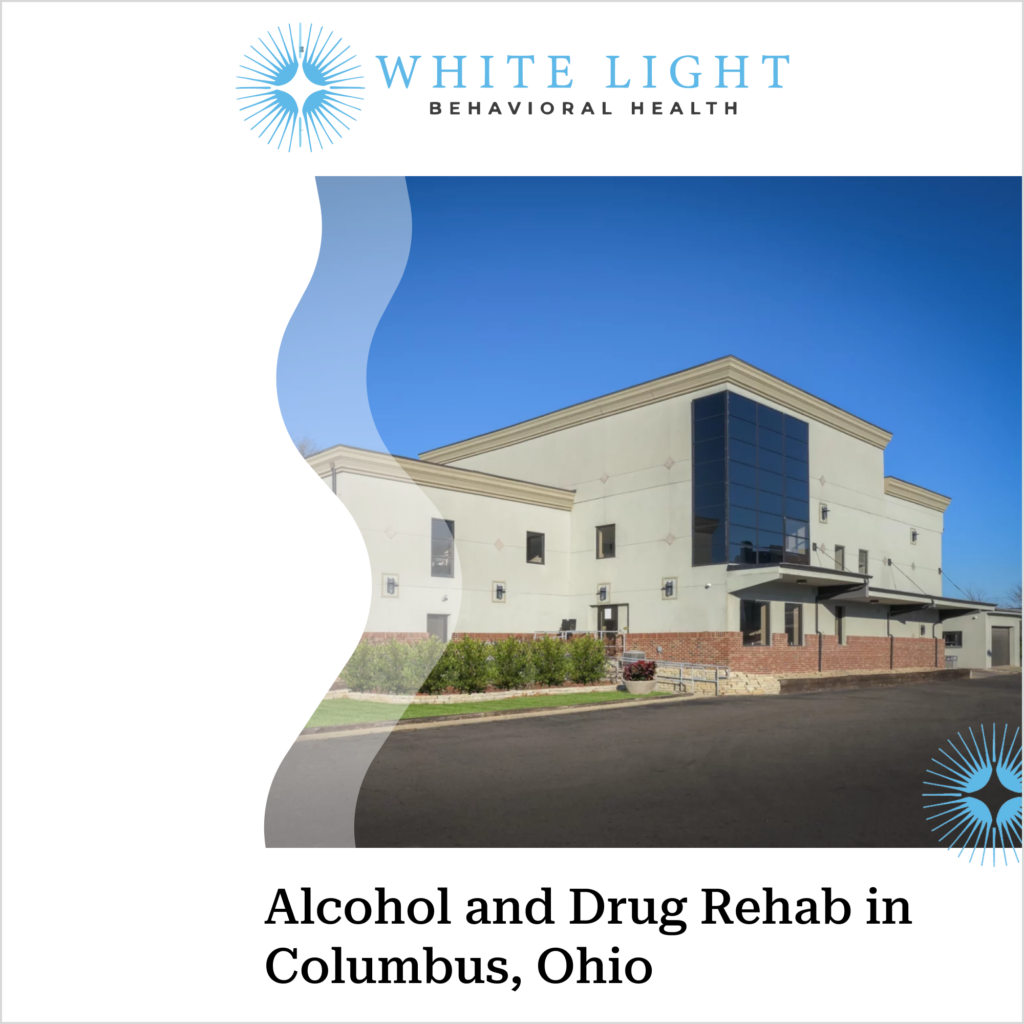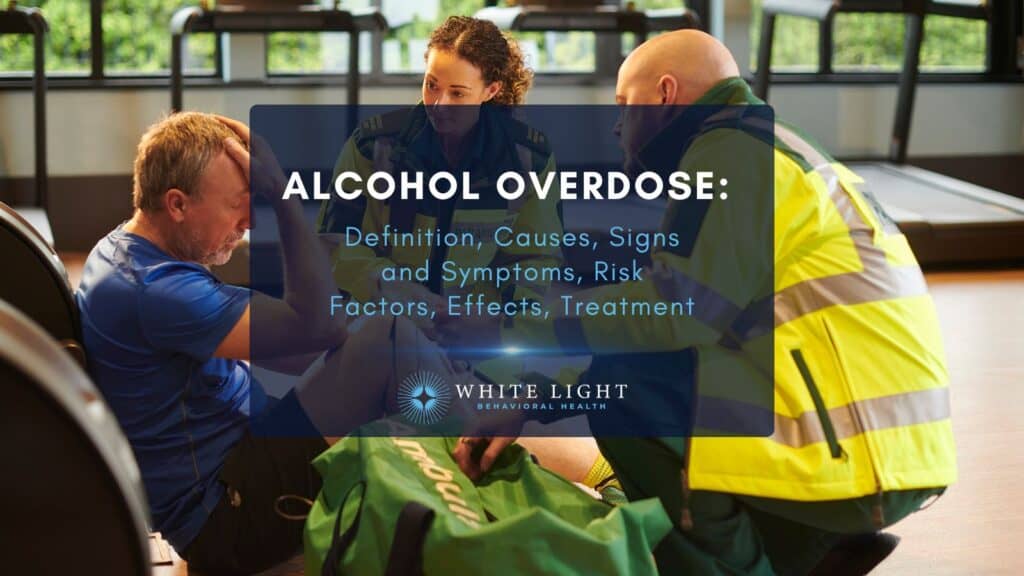Gabapentin: Definition, Uses, Side Effects, Interactions, Warnings
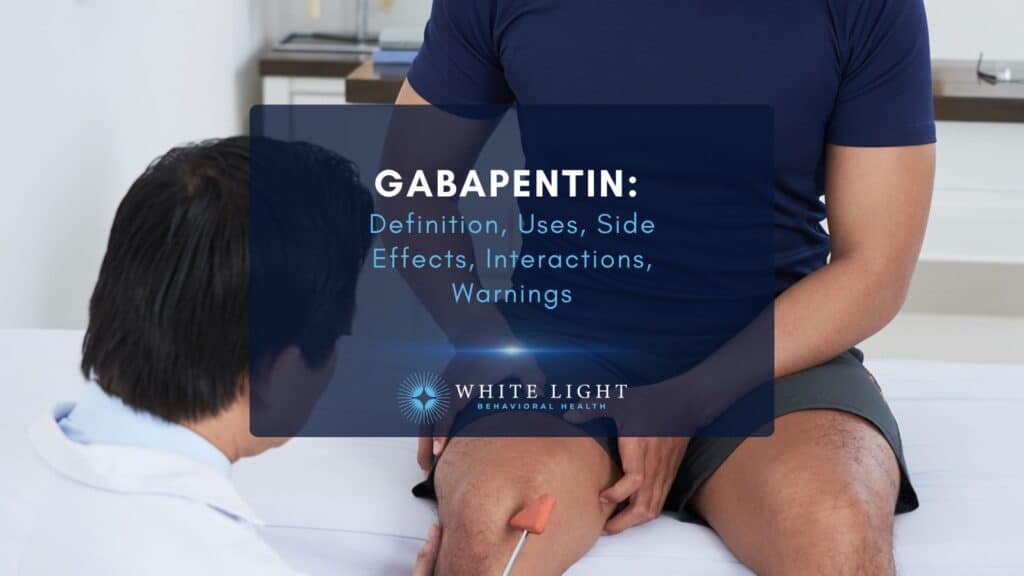
Gabapentin is prescribed to manage conditions affecting the nervous system, helping to alleviate chronic pain, control seizures, and improve neurological discomfort. Gabapentin alters nerve signaling in the brain to reduce pain and seizures.
Beyond its approved uses, Gabapentin is increasingly prescribed off-label for conditions like anxiety, migraines, and fibromyalgia. According to a report by Statista, in 2004, gabapentin was prescribed over 18 million times in the US alone.
Compared to that, in 2022, the number of annual prescriptions for this drug stood at over 40 million.
Common side effects of Gabapentin include dizziness, drowsiness, and fatigue, which subside over time. However, more serious effects, such as respiratory depression, severe allergic reactions, and suicidal thoughts, have been reported. Long-term use at high doses also contributes to Gabapentin addiction, particularly in individuals with a history of substance misuse.
Gabapentin interacts with several medications, including opioids, antidepressants, and antacids. When combined with opioids like Tramadol, it increases the risk of respiratory depression and sedation, as studied by Gomes T et al. 2017, titled “Gabapentin, opioids, and the risk of opioid-related death: A population-based nested case-control study.” Antacids containing magnesium or aluminum reduce Gabapentin absorption, making it less effective, while certain antidepressants enhance its effects, potentially leading to excessive drowsiness.
Precautions when using Gabapentin include proper dose adjustments for individuals with kidney disease, as impaired renal function leads to toxicity. Abruptly stopping the medication causes withdrawal symptoms, including anxiety and seizures, making gradual tapering necessary. Patients should be closely monitored for mood changes, respiratory issues, and signs of misuse or dependence.
What Is Gabapentin?
Gabapentin is an anticonvulsant medication prescribed primarily for managing seizures and nerve pain. It stabilizes nerve activity in the brain, helping to prevent abnormal electrical signals that cause seizures.
Gabapentin is also widely used to treat neuropathic pain, a type of chronic pain resulting from nerve damage. While it was originally developed to control epilepsy, its effectiveness in alleviating nerve-related discomfort has led to broader medical applications.
According to Statista, in 2021, 70.9 million prescriptions were written for gabapentin, a twofold increase from 2011.
More Resources on Addiction:
Did you know most health insurance plans cover substance use disorder treatment? Check your coverage online now.
How Does Gabapentin Work?
Gabapentin works by modulating calcium channels in the central nervous system, reducing excessive nerve signaling that contributes to seizures and nerve pain. Gabapentin does not interact with GABA receptors but instead binds to the α2δ subunit of voltage-gated calcium channels. This binding decreases the release of excitatory neurotransmitters, helping to stabilize nerve activity and alleviate symptoms of epilepsy and neuropathic pain.
Is Gabapentin a Controlled Substance?
No, Gabapentin is not a federally controlled substance, but some U.S. states classify it as a Schedule V drug due to its misuse and addiction potential. While the DEA does not regulate Gabapentin at the federal level, reports indicate increasing abuse, especially among individuals with a history of substance use.
As a result, several states have implemented stricter prescribing and monitoring regulations to curb its misuse. For example, Kentucky became the first state to reclassify gabapentin as a Schedule V controlled substance in 2017, following reports that over one-third of drug overdose deaths in the state involved gabapentin, as discussed by Addiction Resource.net.
What Are the Uses of Gabapentin?
The uses of Gabapentin are primarily for treating seizures and nerve pain, with additional off-label applications for anxiety, insomnia, and withdrawal symptoms. Gabapentin is an FDA-approved drug for epilepsy and postherpetic neuralgia.
It helps regulate nerve activity to prevent seizures and relieve chronic pain caused by nerve damage. Off-label, it is prescribed for conditions such as restless leg syndrome, migraine prevention, and fibromyalgia.
Due to its calming effects on nerve signaling, it is also used to manage withdrawal symptoms from alcohol and opioids.
What Are the Approved Uses of Gabapentin?
Approved uses of Gabapentin are the treatment of epilepsy and postherpetic neuralgia, as recognized by the FDA. It helps manage epilepsy by stabilizing electrical activity in the brain, reducing the frequency and severity of seizures.
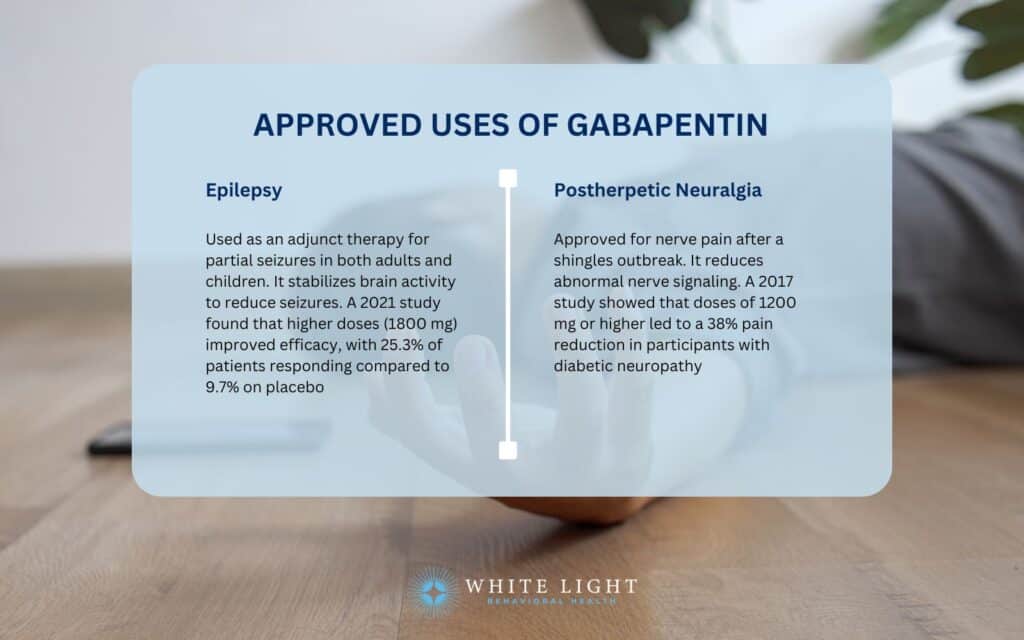
The following are the approved uses of Gabapentin:
- Epilepsy: Gabapentin is FDA-approved for treating epilepsy by stabilizing electrical activity in the brain, helping to prevent and control seizures. It is used as an adjunct therapy for partial seizures in both adults and children.
A dose regression analysis conducted by Panebianco M et al. 2021 in the study titled “Gabapentin add-on treatment for drug-resistant focal epilepsy” found that higher doses of Gabapentin resulted in improved efficacy. The analysis showed that 25.3% of individuals responded to an 1800 mg dose of Gabapentin, compared to 9.7% in the placebo group, reflecting a 15.5% increase in response rate.
- Postherpetic Neuralgia: Gabapentin is approved for managing postherpetic neuralgia, a type of nerve pain after a shingles outbreak.
It reduces abnormal nerve signaling, helping relieve chronic pain and discomfort in affected areas. A study by Wiffen PJ, Derry S, et al. 2017, titled “Gabapentin for chronic neuropathic pain in adults,” found that Gabapentin provided significant pain relief for individuals with painful diabetic neuropathy.
The research indicated that at doses of 1200 mg or higher per day, 38% of participants experienced substantial pain reduction (at least 50%) compared to those receiving a placebo.
What Are the Off-Label Uses of Gabapentin?
The off-label uses of Gabapentin are anxiety, insomnia, fibromyalgia, migraines, and opioid withdrawal, among other conditions. Although not FDA-approved for these uses, doctors prescribe Gabapentin off-label due to its effects on nerve signaling, which helps manage pain, mood disorders, and withdrawal symptoms.

The off-label uses of Gabapentin are as follows:
- Anxiety: Gabapentin is sometimes prescribed to reduce anxiety symptoms by modulating nerve excitability. Research by Hong JSW et al. 2022, in the study “Gabapentin and pregabalin in bipolar disorder, anxiety states, and insomnia: Systematic review, meta-analysis, and rationale,” indicates its effectiveness in generalized anxiety disorder, particularly in patients who do not respond to traditional medications.
The study found that higher doses of Gabapentin (>600 mg) were more effective in reducing preoperative anxiety compared to a 600 mg dose.
- Insomnia: Due to its sedative effects, Gabapentin is used off-label to improve sleep quality, particularly in individuals with chronic pain or restless leg syndrome. A systematic review and meta-analysis by Liu GJ et al. 2017, titled “Efficacy and Tolerability of Gabapentin in Adults with Sleep Disturbance in Medical Illness,” analyzed data from 26 studies involving 4,684 participants.
The findings indicated that Gabapentin provided significantly better outcomes across multiple measures than placebo, with success rates ranging from approximately 50% to 79%. However, the study also reported a 38% increased risk of poor user tolerance.
- Fibromyalgia: Doctors prescribe Gabapentin to manage fibromyalgia-related nerve pain by decreasing abnormal nerve activity.
It helps reduce pain severity and improve daily function.
- Migraines: Gabapentin is sometimes used for migraine prevention, as it helps reduce the frequency and intensity of headaches by stabilizing nerve activity.
- Opioid Withdrawal: Gabapentin is increasingly used to alleviate opioid withdrawal symptoms, such as anxiety, muscle pain, and insomnia, by affecting neurotransmitter release. Gabapentin eases withdrawal severity and improves treatment outcomes.
Contact us today to schedule an initial assessment or to learn more about our services.
Whether you are seeking intensive outpatient care or simply need guidance on your mental health journey, we are here to help.
What Are the Common Side Effects of Gabapentin?
The common side effects of gabapentin are dizziness, drowsiness, and weight gain, among others. These side effects are mild but impact daily activities, especially when starting the medication. Long-term use contributes to more serious effects, requiring medical supervision to ensure safe use.

The common side effects of gabapentin are as follows:
- Dizziness: Many users experience dizziness, particularly when adjusting to the medication, which affects balance and coordination. The body adjusts to the medication, but persistent symptoms require medical attention.
According to Smith BH, Higgins C et al. 2012, “Substance misuse of gabapentin,” gabapentin induces euphoria, dizziness, and mental health issues.
- Drowsiness: Gabapentin causes excessive sleepiness, making it important to avoid activities that require full alertness, such as driving.
- Weight Gain: Some individuals gain weight due to increased appetite and potential metabolic changes while using Gabapentin, as studied by Drugs.com in “Gabapentin Side Effects: Common, Severe, Long Term.”
- Memory Loss: Cognitive effects, including forgetfulness and difficulty concentrating, have been reported because of gabapentin, particularly with prolonged use. A meta-analysis, including 21 studies (4 clinical, 17 preclinical), by Behroozi Z, Jafarpour M, et al. 2023, titled “The effect of gabapentin and pregabalin administration on memory in clinical and preclinical studies: a meta-analysis and systematic review,” found that Gabapentin affects memory, with dosage and timing influencing retention latency, while short-term Pregabalin use in healthy individuals led to temporary CNS side effects.
- Constipation: Gabapentin slows digestion, leading to constipation, which is managed through dietary adjustments and hydration.
- Fatigue: Feelings of tiredness and low energy are common, especially at higher doses or when taken long-term.
- Blurred Vision: Some users experience changes in vision, such as blurriness or difficulty focusing, which require medical attention if persistent.
Does Gabapentin Cause Hair Loss?
Yes, Gabapentin can potentially cause hair loss in some individuals, although this side effect is considered rare.
Hair loss occurs due to indirect factors such as nutrient deficiencies, stress on the body, or medication-induced changes in metabolism. A study by Donovan Hair Clinic, “about 1-2% of people who take gabapentin report hair loss,” suggests that Gabapentin disrupts the hair growth cycle in susceptible individuals.
Still, more research is needed to establish a direct link.
Does Gabapentin Affect a Man’s Sexual Function?
Yes, Gabapentin can cause sexual dysfunction in men, including erectile dysfunction and decreased libido. Gabapentin affects neurotransmitter function in the central nervous system and reduces blood flow, leading to these side effects. However, the severity of these effects varies among individuals. A study by Kaufman KR, Struck PJ. et al. 2011, titled “Gabapentin-induced sexual dysfunction,” gabapentin-induced sexual dysfunction is dose-dependent, with reports of total sexual dysfunction (loss of libido, anejaculation, anorgasmia, and impotence) occurring at doses as low as 300 mg daily.
What Organ Is Gabapentin Hard On?
Gabapentin is hard on the kidneys, as it is primarily excreted through renal pathways. Patients with kidney impairment have difficulty clearing the drug from their system, leading to an increased risk of side effects or toxicity. Dose adjustments are necessary for individuals with renal dysfunction to prevent accumulation and potential adverse effects. According to a study by Zand L, McKian KP, Qian Q., et al. 2010, titled “Gabapentin toxicity in patients with chronic kidney disease: a preventable cause of morbidity,” gabapentin toxicity was found in 5.56% of patients with reduced kidney function and 77.8% of those on dialysis, with higher serum levels compared to those with normal kidney function.
What Are the Serious Side Effects of Gabapentin?
The serious side effects of Gabapentin include respiratory depression, suicidal thoughts, severe allergic reactions, and coordination problems. These adverse effects are rare but are severe, requiring immediate medical attention, especially in individuals with preexisting conditions or those taking other central nervous system depressants. The FDA has issued safety warnings: “FDA warns about serious breathing problems with seizure and nerve pain medicines gabapentin (Neurontin, Gralise, Horizant) and pregabalin (Lyrica, Lyrica CR),” about the potential for respiratory depression, particularly in patients with chronic respiratory diseases or those using opioids.
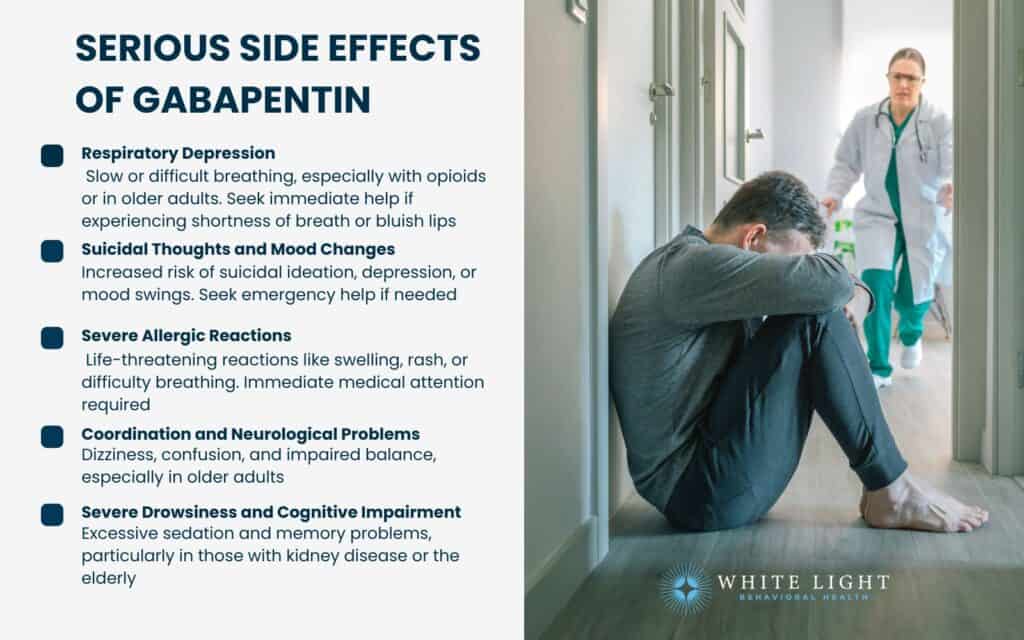
The serious side effects of Gabapentin are as follows:
- Respiratory Depression: Gabapentin causes dangerously slow or difficult breathing, particularly in older adults, individuals with lung disease, or those taking opioids. The FDA issued a safety warning in 2019 highlighting the risk of life-threatening respiratory depression, urging caution when prescribing Gabapentin with other central nervous system depressants.
Seek immediate medical attention if experiencing severe shortness of breath, bluish lips or fingers, or extreme drowsiness.
- Suicidal Thoughts and Mood Changes: The FDA has warned that Gabapentin increases the risk of suicidal ideation, particularly in individuals with a history of mental health disorders. Symptoms include new or worsening depression, mood swings, agitation, or thoughts of self-harm.
Patients and caregivers should monitor for these signs and seek emergency help if suicidal thoughts arise.
- Severe Allergic Reactions (Anaphylaxis and DRESS Syndrome): Although rare, Gabapentin triggers life-threatening allergic reactions, including Drug Reaction with Eosinophilia and Systemic Symptoms (DRESS). Symptoms include swelling of the face, throat, or tongue, difficulty breathing, severe rash, fever, and swollen lymph nodes.
Immediate emergency care is required if any of these symptoms occur.
- Coordination and Neurological Problems: Gabapentin causes dizziness, loss of balance, confusion, and impaired motor coordination, increasing the risk of falls and injuries, especially in older adults. These effects worsen when combined with alcohol or other sedatives.
Medical attention is advised if experiencing severe dizziness or an inability to walk properly.
- Severe Drowsiness and Cognitive Impairment: Some individuals, particularly those with kidney disease or the elderly, experience excessive sedation, confusion, and memory problems. A case study published in Mayo Clinic Proceedings highlighted cases where Gabapentin toxicity led to profound sedation in patients with kidney impairment.
Rediscover Life at White Light Behavioral Health
Get the compassionate support you deserve.
We're here to help you reclaim joy, wellness, and a brighter future.
Our Facility
How Does Gabapentin Interact with Other Medications?
Gabapentin interacts with other medications by either enhancing their effects or reducing its own absorption, which leads to increased risks of side effects. It interacts with other medications, including antihistamines, muscle relaxants, and alcohol, leading to heightened drowsiness and dizziness. These interactions are especially concerning when combined with central nervous system (CNS) depressants or medications that affect its absorption.
Gabapentin interacts with other medications in the following ways:
- Opioids (Increased Sedation and Respiratory Depression): Gabapentin, when taken with opioids such as oxycodone, morphine, or hydrocodone, significantly increases sedation and suppresses breathing. According to a study by Gomes T et al. 2017, titled “Gabapentin, opioids, and the risk of opioid-related death: A population-based nested case-control study,” found that among patients receiving prescription opioids, concomitant treatment with gabapentin was associated with a substantial increase in the risk of opioid-related death.
Patients using both medications must be closely monitored for symptoms like extreme drowsiness, confusion, or slow breathing.
- Antidepressants (Enhanced CNS Effects): Gabapentin intensifies the effects of antidepressants, including selective serotonin reuptake inhibitors (SSRIs) and tricyclic antidepressants (TCAs). According to a study by Kremer M, Salvat E et al. 2016, titled “Antidepressants and gabapentinoids in neuropathic pain: Mechanistic insights,” this leads to increased dizziness, drowsiness, and cognitive impairment.
While some doctors prescribe Gabapentin alongside antidepressants for conditions like anxiety or nerve pain, caution is advised to avoid excessive sedation or mood disturbances.
- Antacids (Reduced Gabapentin Absorption): Antacids containing aluminum or magnesium, such as Maalox and Mylanta, reduce Gabapentin’s absorption by up to 20%, potentially making it less effective. A study by Yagi T, Naito T, Mino Y, Umemura K, Kawakami J. et al. 2012, titled “Impact of concomitant antacid administration on gabapentin plasma exposure and oral bioavailability in healthy adult subjects” evaluating the effects of antacids on Gabapentin absorption found that magnesium oxide (MgO) significantly reduced Gabapentin’s bioavailability by 32-39% by decreasing its intestinal absorption.
Key pharmacokinetic parameters, including Cmax, Tmax, and AUC, were also lowered by 29-46% when Gabapentin was taken with MgO. In contrast, omeprazole did not affect Gabapentin’s absorption or bioavailability. It is recommended to take Gabapentin at least two hours after an antacid to ensure proper absorption to prevent this adverse interaction.
Can You Take Gabapentin with Alcohol?
No, you cannot take Gabapentin with alcohol because combining Gabapentin with alcohol increases the risk of severe side effects, including extreme drowsiness, dizziness, impaired coordination, and blackouts. Both substances depress the central nervous system, which leads to respiratory depression and a higher risk of overdose.
According to SingleCare, mixing Gabapentin with alcohol also impairs cognitive function and reaction times, increasing the risk of accidents and injuries.
Can You Take Gabapentin with Ibuprofen, Tylenol or Tramadol?
Yes, Gabapentin can be safely taken with Ibuprofen or Tylenol (acetaminophen), but it requires careful monitoring when combined with Tramadol due to increased sedation and overdose risk. Ibuprofen, a nonsteroidal anti-inflammatory drug (NSAID), and Tylenol, a common pain reliever, do not interact negatively with Gabapentin and are considered safe for managing pain.
However, Tramadol, an opioid pain reliever, interacts with Gabapentin by enhancing sedative effects, potentially leading to respiratory depression and overdose. Patients should consult a doctor before combining Gabapentin with Tramadol or any other opioids.
The following drugs are safe to take with Gabapentin:
- Ibuprofen (NSAID): Gabapentin can be taken with Ibuprofen for pain relief without significant risk of interactions. Ibuprofen helps reduce inflammation and pain without affecting Gabapentin’s mechanism of action.
Unlike opioids, it does not enhance sedation or dizziness, making it a safer option for individuals managing chronic pain conditions.
- Tylenol (Acetaminophen): Acetaminophen is another safe option for pain relief when taken with Gabapentin. It is commonly used for mild to moderate pain and fever without causing drowsiness or dizziness.
However, it should be taken in moderation to avoid liver toxicity, especially in individuals with pre-existing liver conditions.
The following drugs are unsafe to take with Gabapentin:
- Tramadol (Opioid Pain Reliever): Tramadol and Gabapentin both have sedative properties, and when taken together, they increase the risk of severe drowsiness, dizziness, confusion, and respiratory depression. In extreme cases, this combination leads to life-threatening overdose symptoms.
A healthcare provider should closely monitor individuals using both medications to prevent dangerous side effects.
- Other Opioids (e.g., Oxycodone, Hydrocodone, Morphine): Similar to Tramadol, stronger opioids like Oxycodone, Hydrocodone, and Morphine exacerbate Gabapentin’s sedative effects, significantly increasing the risk of respiratory depression, confusion, and potential overdose. Long-term use of this combination also contributes to physical dependence and withdrawal complications.
Patients should avoid combining Gabapentin with opioids unless necessary and prescribed under strict medical supervision.
What Precautions Should Be Taken When Using Gabapentin?
Precautions that should be taken when using Gabapentin include adjusting the dose for individuals with kidney disease, avoiding abrupt discontinuation, monitoring for mood changes, and being aware of potential drug interactions. These precautions are necessary to minimize risks such as withdrawal symptoms, increased sedation, and worsening mental health conditions.
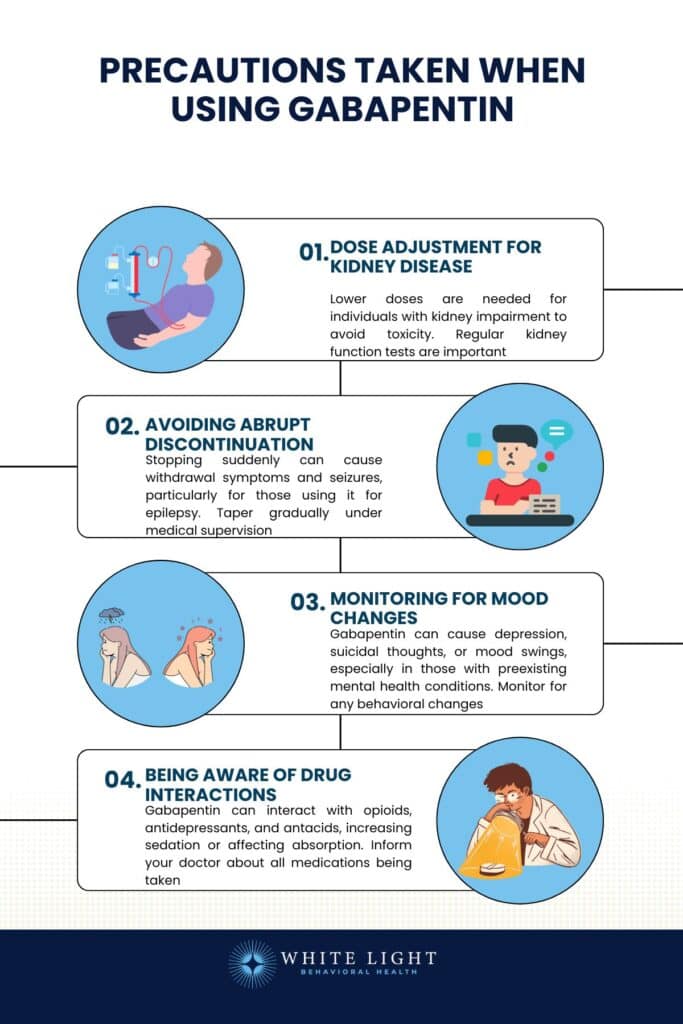
The following precautions should be taken when using Gabapentin:
- Dose Adjustment for Kidney Disease: Gabapentin is primarily excreted through the kidneys, so individuals with impaired kidney function need lower doses to prevent drug accumulation and toxicity. A study by Zand L, McKian KP, Qian Q., et al. 2010, titled “Gabapentin toxicity in patients with chronic kidney disease: a preventable cause of morbidity,” has shown that improper Gabapentin dosing in patients with chronic kidney disease increases the risk of severe side effects, including excessive drowsiness and confusion.
Regular kidney function tests are required to ensure safe usage.
- Avoiding Abrupt Discontinuation: Stopping Gabapentin suddenly leads to withdrawal symptoms such as anxiety, nausea, sweating, and, in severe cases, seizures. This is especially important for individuals taking Gabapentin for epilepsy, as abrupt discontinuation triggers rebound seizures.
A gradual tapering plan should always be followed under medical supervision.
- Monitoring for Mood Changes: Gabapentin has been linked to increased risks of depression, suicidal thoughts, and mood swings, especially in individuals with preexisting mental health conditions. The FDA has issued warnings about this risk, advising patients and caregivers to monitor for any unusual mood or behavioral changes and seek medical attention if symptoms worsen.
- Being Aware of Drug Interactions: Gabapentin interacts with opioids, antidepressants, and antacids, leading to increased sedation, decreased drug absorption, or heightened central nervous system effects.
Combining Gabapentin with opioids like Tramadol or Hydrocodone increases the risk of respiratory depression and overdose, while antacids containing aluminum or magnesium reduce their effectiveness. Patients should inform their healthcare provider of their medications to avoid harmful interactions.
What Should You Avoid While Taking Gabapentin?
You should avoid alcohol, grapefruit juice, magnesium-containing supplements, and opioids while taking Gabapentin, as these substances interfere with its effectiveness and increase the risk of severe side effects. Combining Gabapentin with certain substances leads to heightened sedation, reduced drug absorption, and an increased risk of overdose.
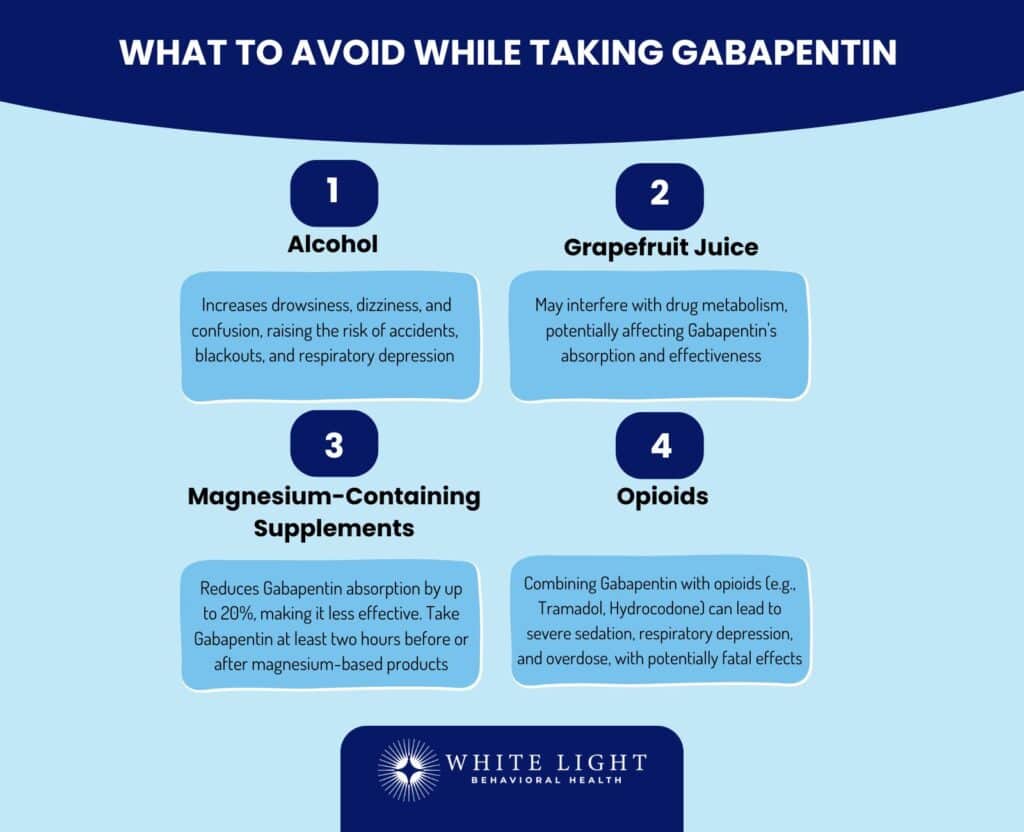
You should avoid the following things while taking Gabapentin:
- Alcohol: Mixing Gabapentin with alcohol intensifies drowsiness, dizziness, and confusion, increasing the risk of accidents, blackouts, and respiratory depression. This combination also leads to enhanced central nervous system depression, potentially causing dangerous sedation or even overdose.
- Grapefruit Juice: Although not as widely recognized, grapefruit juice alters how certain drugs are metabolized in the liver.
While evidence on Gabapentin specifically is limited, avoiding grapefruit juice is recommended as a precaution to prevent unexpected interactions that could affect the drug’s absorption or effectiveness.
- Magnesium-Containing Supplements: Antacids or supplements containing magnesium significantly reduce Gabapentin absorption by up to 20%, making it less effective, as studied by GoodRx. Take Gabapentin at least two hours before or after consuming magnesium-based products to avoid this.
- Opioids: Opioids like Tramadol, Hydrocodone, or Oxycodone interact dangerously with Gabapentin, leading to severe sedation, respiratory depression, and an increased risk of overdose.
The FDA has issued warnings titled “FDA warns about serious breathing problems with seizure and nerve pain medicines gabapentin (Neurontin, Gralise, Horizant) and pregabalin (Lyrica, Lyrica CR)” about the potentially fatal effects of combining these medications, emphasizing the need for close monitoring when co-prescribed.
Are you covered for treatment?
White Light Behavioral Health is an approved provider for Blue Cross Blue Shield and TUFTS, while also accepting many other major insurance carriers.
Check Coverage Now!How Long Does Gabapentin Stay in Your System?
Gabapentin stays in your system for approximately 1 to 2 days, depending on factors like metabolism and kidney function, according to the Mayo Clinic. Its half-life is around 5 to 7 hours, meaning it takes that long for half of the drug to leave the body. Gabapentin is detected in urine for up to 3 days, in blood for about 5 to 7 hours, and in hair for up to 90 days, though hair tests are uncommon.
Does Gabapentin Show Up on a Drug Test?
No, Gabapentin does not show up on standard drug tests. Most routine screenings for employment or probation do not check for Gabapentin, as it is not a controlled substance federally. However, some addiction treatment centers and certain states include Gabapentin in their drug testing panels due to concerns about misuse and dependency.
Can Gabapentin Lead to Dependence or Addiction?
Yes, Gabapentin can lead to dependence and addiction, particularly in individuals with a history of substance use. Gabapentin is not classified as a controlled substance federally. Long-term or chronic use results in cravings and misuse, especially when combined with other drugs like opioids.
Research from NIDA and SAMHSA indicates that Gabapentin misuse is rising, with many polydrug users taking it to enhance the effects of opioids or other depressants. Studies also suggest that those using Gabapentin recreationally experience withdrawal symptoms, reinforcing dependence and gabapentin addiction.
Is Gabapentin Misused or Abused?
Yes, Gabapentin is increasingly misused and abused. According to a study by Smith RV, Havens JR, Walsh SL. et al. 2016, titled “Gabapentin misuse, abuse and diversion: a systematic review,” the prevalence of gabapentin misuse in the general population was reported to be 1%, 40–65% among individuals with prescriptions, and between 15–22% within populations of people who abuse opioids Research by Lennox R, Mangin D. et al. 2019, titled “Gabapentin misuse” suggests that Gabapentin abuse is common in individuals with a history of substance use, as it enhances the effects of other central nervous system depressants, increasing sedation and intoxication.
Can You Overdose on Gabapentin?
Yes, you can overdose on Gabapentin, especially when combined with opioids or alcohol. While Gabapentin alone has a low overdose risk, CDC reports indicate that it has been implicated in fatal overdoses when mixed with opioids like fentanyl. According to Kuehn BM et al. 2022, titled “ Gabapentin Increasingly Implicated in Overdose Deaths,” from 2019 to 2020, gabapentin was detected in 5,687 overdose deaths in the United States, which was about 10% of all overdose deaths with test results. The number of fatalities involving gabapentin doubled from the first quarter of 2019 to the second quarter of 2020.
What Are the Signs of Gabapentin Overdose?
The signs of Gabapentin overdose are severe drowsiness, respiratory depression, loss of coordination, and coma, and these signs require immediate medical attention. Symptoms range from mild to life-threatening, depending on the dose and whether other substances are involved. In case of an overdose, seek emergency medical help immediately by calling 911.

The following are the signs of Gabapentin overdose:
- Severe drowsiness and confusion: Excessive sleepiness, difficulty staying awake, or extreme mental fog are early warning signs of Gabapentin overdose.
- Respiratory depression: Slowed or labored breathing occurs, especially when Gabapentin is mixed with other sedatives.
- Loss of coordination: Impaired motor control, dizziness, and difficulty walking indicate an overdose.
- Coma and unresponsiveness: In severe cases, individuals lose consciousness or enter a coma, requiring emergency intervention.
Did you know most health insurance plans cover substance use disorder treatment? Check your coverage online now.
Can Gabapentin Cause Withdrawal Symptoms?
Yes, Gabapentin can cause withdrawal if the medication is stopped suddenly. The severity of withdrawal symptoms depends on the dosage, duration of use, and individual health factors. Common withdrawal symptoms include anxiety, irritability, increased nervousness, restlessness, and mood swings.
Many individuals experience insomnia and sleep disturbances accompanied by nightmares. Other symptoms include nausea, gastrointestinal discomfort, excessive sweating, chills, and flu-like symptoms.
In severe cases, sudden discontinuation of Gabapentin triggers seizures, especially in those with epilepsy or long-term high-dose users. A study by Yesil, B., and Elbozan, B. 2016, titled “Gabapentin withdrawal in a depressed patient: A case report” states that symptoms last from several days to weeks, making medical supervision necessary.
How Can Gabapentin Withdrawal Be Managed Safely?
Gabapentin withdrawal can be managed safely through gradual tapering under medical supervision. Abruptly stopping the medication leads to severe withdrawal symptoms, so following a structured withdrawal protocol is important. Doctors reduce the dosage gradually over several weeks to minimize withdrawal effects and monitor symptoms to adjust the tapering schedule as needed.
Staying hydrated, getting adequate rest, and using supportive medications help alleviate withdrawal discomfort. For individuals who have been on high doses, healthcare providers prescribe alternative medications to prevent seizures during withdrawal.
Proper medical supervision ensures a safer and more comfortable transition off Gabapentin while reducing the risk of complications.
Is It Safe to Stop Taking Gabapentin Abruptly?
No, it is not safe to stop taking Gabapentin abruptly because it causes severe withdrawal symptoms, including seizures, anxiety, and agitation. A gradual tapering process under medical supervision is necessary to minimize risks. Stopping suddenly is dangerous, particularly for individuals taking high doses or for long-term users.
How Does Gabapentin Compare to Other Nerve Pain Medications Like Pregabalin and Lyrica?
Gabapentin is compared to other nerve pain medications like Pregabalin and Lyrica in terms of potency, side effects, and effectiveness. While all three drugs are used for neuropathic pain, Pregabalin (sold under the brand name Lyrica) is stronger and more potent than Gabapentin, meaning lower doses are required for similar effects. Gabapentin takes longer to reach its peak effect and is absorbed less efficiently, requiring higher doses to achieve therapeutic benefits.
In contrast, Pregabalin has better bioavailability, allowing it to work faster and at lower doses, but this also increases its potential for misuse. Both medications share common side effects, such as dizziness and drowsiness.
However, Pregabalin is more frequently associated with euphoria and dependence, making it a higher-risk option for individuals with a history of substance misuse.
Is Gabapentin a Strong Painkiller?
Gabapentin is not a strong painkiller in the traditional sense, as it does not provide immediate pain relief like opioids. Instead, it stabilizes nerve activity, making it effective for chronic nerve pain conditions such as diabetic neuropathy and postherpetic neuralgia. Unlike opioids, it does not block pain directly but instead reduces nerve sensitivity over time.
Which Is Stronger: Gabapentin or Tramadol?
Tramadol is considered stronger than Gabapentin for acute pain relief, while Gabapentin is more effective for long-term nerve pain management. Tramadol is an opioid analgesic that provides immediate pain relief by acting on opioid receptors and inhibiting pain signals.
In contrast, Gabapentin is not an opioid and works gradually over time by affecting nerve signaling, making it better suited for chronic neuropathic pain. While Tramadol is more potent for short-term pain relief, Gabapentin is preferred for long-term use due to its lower risk of dependence and addiction.
What Are Natural Alternatives to Gabapentin?
Natural alternatives to Gabapentin include various supplements and therapies that help manage nerve pain and inflammation. These alternatives provide pain relief through anti-inflammatory, neuroprotective, and muscle-relaxing properties.
The following are the natural alternatives to Gabapentin:
- Turmeric (Curcumin): A powerful anti-inflammatory compound that helps reduce nerve pain by lowering inflammation and oxidative stress. A study by Kapoor S. et al. 2012, titled “Curcumin and its Emerging Role in Pain Modulation and Pain Management,” suggests curcumin modulates pain pathways similarly to some medications.
- Omega-3 Fatty Acids: Omega-3s are found in fish oil and flaxseeds and support nerve health by reducing inflammation and promoting nerve regeneration.
Research by Galán-Arriero I et al. 2017, titled “The Role of Omega-3 and Omega-9 Fatty Acids for the Treatment of neuropathic pain after Neurotrauma,” indicates they improve symptoms of neuropathy and chronic pain conditions.
- Magnesium: Magnesium is fundamental for nerve function and muscle relaxation. It helps reduce nerve pain and prevent muscle cramps.
Magnesium deficiency has been linked to increased nerve sensitivity and pain.
Acupuncture: A traditional Chinese medicine technique that involves inserting thin needles into specific points on the body to stimulate nerve function and reduce pain. Acupuncture helps alleviate neuropathic pain by promoting blood circulation and releasing endorphins.
Share This Post







